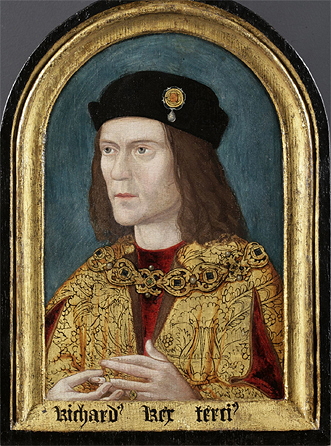From Wikipedia, the free encyclopedia
(Redirected from King Richard III)
"Richard of Gloucester" redirects here. For the grandson of George V of the United Kingdom, see Prince Richard, Duke of Gloucester.
"Richard III" redirects here. For the play by Shakespeare, see Richard III (play). For other uses, see Richard III (disambiguation).
| Richard III | |
|---|---|

The earliest surviving portrait of Richard (c. 1520, after a lost original), formerly belonging to the Paston family
(Society of Antiquaries, London) | |
| King of England (more...) | |
| Reign | 26 June 1483 – 22 August 1485 |
| Coronation | 6 July 1483 |
| Predecessor | Edward V |
| Successor | Henry VII |
| Consort | Anne Neville |
| Issue |
|
| House | House of York |
| Father | Richard Plantagenet, Duke of York |
| Mother | Cecily Neville, Duchess of York |
| Born | 2 October 1452 Fotheringhay Castle, Northamptonshire |
| Died | 22 August 1485 (aged 32) Bosworth Field, Leicestershire |
| Burial | Greyfriars, Leicester (reburial planned for Leicester Cathedral26 March 2015) |
| Religion | Roman Catholicism |
| Signature |  |
| English Royalty |
| House of York |
|---|

|
| Richard Plantagenet, 3rd Duke |
| Richard III |
Richard III (2 October 1452 – 22 August 1485) was King of England from 1483 until his death in 1485 in the Battle of Bosworth Field. He was the last king of the House of York and the last of the Plantagenet dynasty. His defeat at Bosworth Field, the last decisive battle of the Wars of the Roses, marks the end of the Middle Ages in England. He is the subject of the fictional historical play Richard III by William Shakespeare.
When his brother King Edward IV died in April 1483, Richard was named Lord Protector of the realm for Edward's son and successor, the 12-year-old Edward V. As the young King travelled to London from Ludlow, Richard met and escorted him to lodgings in the Tower of London where Edward V's brother Richard joined him shortly afterwards. Arrangements were made for Edward's coronation on 22 June 1483, but before the young king could be crowned, his father's marriage to his mother Elizabeth Woodvillewas declared invalid, making their children illegitimate and ineligible for the throne. On 25 June, an assembly of lords and commoners endorsed the claims. The following day, Richard III began his reign, and he was crowned on 6 July 1483. The young princes were not seen in public after August, and accusations circulated that the boys had been murdered on Richard's orders, giving rise to the legend of the Princes in the Tower.
There were two major rebellions against Richard. The first, in October 1483, was led by staunch allies of Edward IV[1] and also by Richard's former ally, Henry Stafford, 2nd Duke of Buckingham;[2] the revolt collapsed. In August 1485, another rebellion against Richard was led by Henry Tudor and his uncle, Jasper Tudor. Henry Tudor landed in southern Wales with a small contingent of French troops, and then marched through his birthplace, Pembrokeshire, recruiting more soldiers. Henry's force engaged Richard's army and defeated it at the Battle of Bosworth Field in Leicestershire. Richard was struck down in this conflict, making him the last English king to die in battle on home soil, and the first to do so since Harold II was killed at the Battle of Hastings in 1066.TO BE RE INTERNED ON THURSDAY 26 03 2015 AT CHURCH OF ENGLAND CATHEDRAL LEICESTER ALSO LIVE EVENTS ON -http://www.channel4.com/info/press/news/week-of-exclusive-live-programming-for-burial-of-king-richard-iii-READ MORE -http://en.wikipedia.org/wiki/Richard_III_of_England


